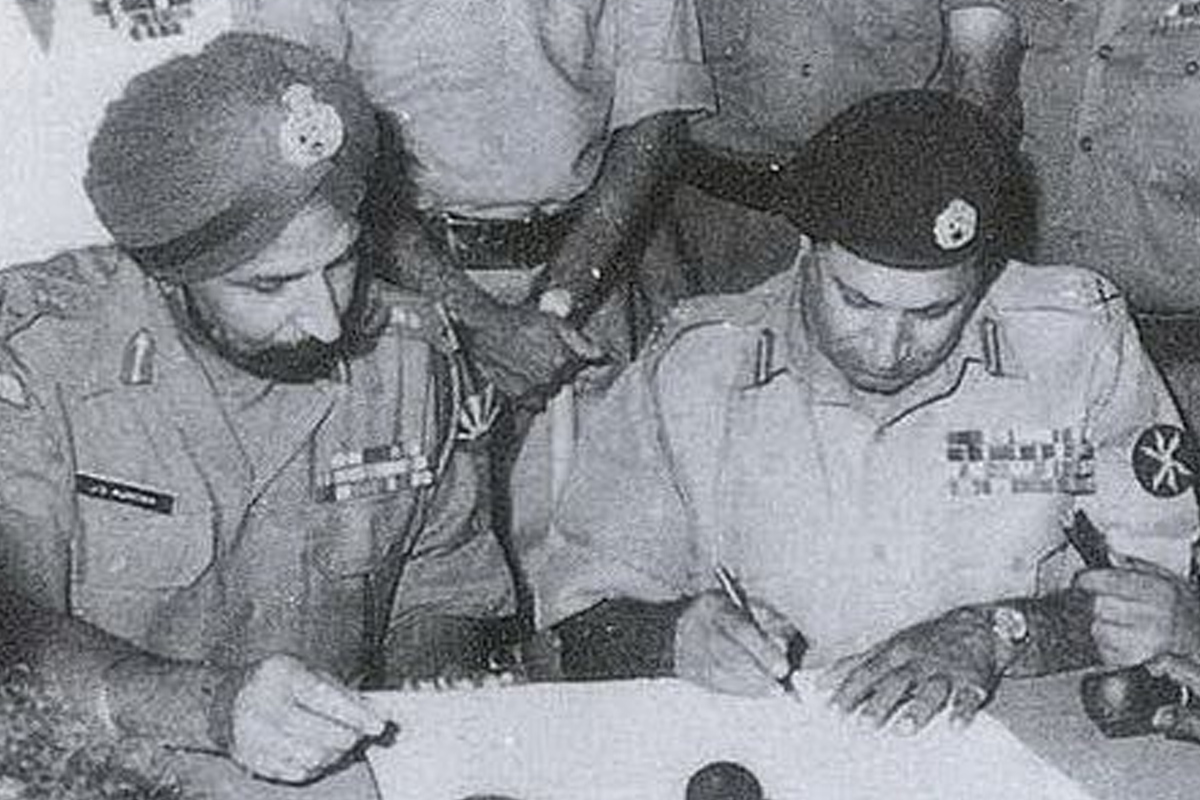‘India vs Pakistan’ docu-series: Netflix unveils rivalry ahead of Champions Trophy
Netflix is set to release 'The Greatest Rivalry: India vs Pakistan' on February 7, offering exclusive insights ahead of their Champions Trophy clash on February 23.
And they did that. East Pakistan was sliced off from West Pakistan. Lt Gen Panag vividly remembers that day too, the day Bangladesh was born.

Photo: Wikipedia
Dhaka, December 16, 1971. It was the day that Pakistan surrendered in the Indo-Pak War. And it was the day that Bangladesh was born.
Among those to still recall that day, fifty-two years ago, in vivid detail, is Lt. General H.S. Panag (Retd). He was twenty-three years old at that time and an officer in the Indian Army. His formation had been stationed in West Bengal’s northern district of Nadia, near the border with what was then East Pakistan.
Advertisement
December 16, 1971, was preceded by days and months of atrocities that rulers of West Pakistan had unleashed on the East Pakistani Bengalis.
Advertisement
On March 25 that year the Pakistani Army, controlled by West Pakistan, had launched “Operation Searchlight”, the codename for a planned, military operation, the goal of which was to crush and really eradicate the movement by East Pakistan’s Bengali-speaking population for autonomy.
On March 26, the day after the genocide started, Lt Gen Panag remembers the road from Boyra (near East Pakistan’s border with West Bengal) all the way down to Ranaghat, fifty-four kilometers away, being choked with refugees fleeing East Pakistan. “I recall the sheer numbers….it was a sight that is etched in my memory,” he says.
The demand for autonomy had, of course, been brewing for over two decades. As early as 1947, soon after India was partitioned and East and West Pakistan came into being by carving out parts of Bengal and Punjab, it became amply clear to the Bengali-speaking population of East Pakistan that West Pakistan would take control of everything from the governance to the economy to even the culture and the language of the newly-formed country. This period is well-documented.
In his foreword to the tome, “Heroes of 1971: The Bravehearts of the War That Gave Birth to Bangladesh,” edited by The Tribune editor-in-chief Rajesh Ramachandran, NN Vohra, President of The Tribune Trust, Chandigarh gives it fresh perspective.
He writes, “While India had, since Independence, remained intensively engaged in tackling the challenges of nation-building and placing its democratic framework on a firm footing, the governance of Pakistan, had since 1958, firmly settled in the hands of its military generals, who were openly opposed to democracy.”
He further points out, “Pakistan’s eastern wing, East Pakistan, lay 1,600 kilometers away from West Pakistan. In terms of growth and development, it had suffered adversely for many years because of the highly discriminatory policies of the federal government of Pakistan, which had refused to provide the much-needed political and economic support to East Pakistan. As unashamedly pronounced by the commanding Pakistani generals, one of the reasons for their harsh treatment of the people of East Bengal was because they ‘were not Urdu but Bengali speaking’.”
Indeed, the demand for recognition of the Bengali language as one of Pakistan’s official languages and the dissent that stemmed from the outright refusal to pay heed to this demand resulted in the first violent clashes between East Pakistanis and the rulers of West Pakistan. In what has come to be known as one of Bangladesh’s bloodiest days and one which has gone down in history as “Martyr’s Day” is February 21, 1952. On this day, just four years after Independence, Pakistani police opened fire on protesters demanding the recognition of their language Bengali as an official language. They included intellectuals, activists, teachers and students, including scholars of Dhaka University.
Five men, Abdus Salam, Abdul Barkat, Rafiq Uddin Ahmed, Abdul Jabbar and Shafiur Rahman were killed in that police firing and many were injured.
Though the dissent was temporarily and outwardly crushed, the anger, the fury, the frustration and the restlessness continued to simmer just underneath the surface. And then it erupted. Finally, the day after the pogrom, on March 26, 1971, Mujibar Rahman, then a rising star in Pakistani politics and leader of the political party Awami League (which had swept the elections but was denied by West Pakistan’s military government the right to govern) declared Independence from the tyrannical and oppressive West Pakistan.
Documenting the period in his book, “India’s Secret War, BSF and Nine Months to the Birth of Bangladesh,” journalist Ushinor Majumdar writes on how India’s Border Security Force too, along with India’s armed forces, played a crucial role in helping Bangladesh wrest freedom from West Pakistan including taking part in training the
“Mukti Bahini”, the now celebrated guerilla warriors of the liberation war.
War was formally declared on December 3, 1971 and thirteen days later, Pakistan surrendered and Bangladesh was born. Lt Gen Panag recalls a speech made by his then senior in the Indian Army, Lt Gen Aurora, who was addressing his officers. “He said, ‘Hum Pakistan ke tukde tukde kar denge’ (We will shred Pakistan to bits),” says Lt Gen Panag, quoting Lt Gen Aurora.
And they did that. East Pakistan was sliced off from West Pakistan. Lt Gen Panag vividly remembers that day too, the day Bangladesh was born.
“The Indian Army had brought about psychological collapse of the Pakistan Army. At Dacca.” Dacca had become the “Centre of Gravity”, explains Lt Gen Panag. It was part of the strategy of the Indian Army to psychologically destroy the Pakistan Army, which was thrown off-guard, expecting the fighting to be nearer the borders. “They were a 30,000 strong force. We had only 3,000 surrounding Dacca,” points out Lt Gen Panag. But the Pakistani Army had psychologically given up. It was a matter of time before it surrendered.
And the rest, of course, is history.
Advertisement